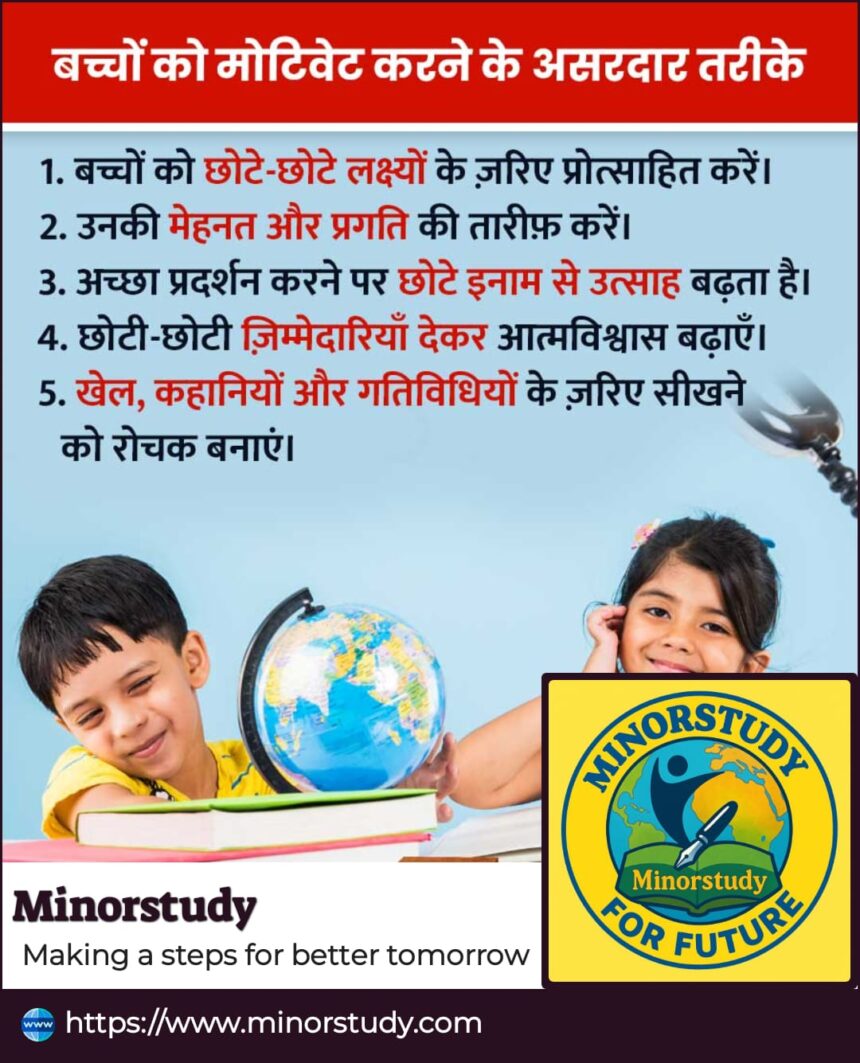🌟 5 Magical Ways to Motivate Children: Boost Confidence & Joy Through Smart Parenting
In the journey of parenting, motivating children is not just about pushing them to achieve more — it’s about nurturing their inner spark, encouraging healthy habits, and helping them believe in themselves. The world today is full of distractions and pressures, and our children need more guidance, support, and positivity than ever.
- 🏛️ History: Motivation Through the Ages
- 📅 Timeline: Evolution of Motivation Techniques
- 💡 5 Magical Ways to Motivate Children
- 🎯 1. Set Small, Achievable Goals
- 👏 2. Praise Their Effort, Not Just Results
- 🎁 3. Use Small Rewards as Exciting Encouragement
- 💪 4. Give Small Responsibilities to Build Confidence
- 🎲 5. Make Learning Fun with Stories and Activities
- 📌 Significance in Daily Life
- 🙋♂️ Frequently Asked Questions (FAQs)
- ❓ Q. What if my child doesn’t respond to rewards?
- ❓ Q. How to motivate without putting pressure?
- ❓ Q. Is it okay to let children fail sometimes?
- ❓ Q. How often should I praise?
- 🎉 Wishing: Inspire the Young, Empower the Future
- 🧠 Key Points Summary
- 🧭 Conclusion: Motivation is Love in Action
This detailed and friendly guide explores history, facts, FAQs, timeline, significance, impact in daily life, and more — on the art of motivating children effectively, using gentle, real-world techniques. Whether you’re a parent, teacher, or caregiver, these insights will transform how you connect with and inspire young minds.
🏛️ History: Motivation Through the Ages
Motivating children isn’t new — ancient societies too believed in shaping character early.
Vedic Gurukuls used inspiration through storytelling, rituals, and personal guidance.
Chanakya’s teachings emphasized a balance of discipline and emotional motivation.
In traditional Indian homes, elders motivated children through real-life tales, moral fables, and value-based stories.
In modern psychology, researchers like Jean Piaget and Maria Montessori laid the foundation of child-centric education, focusing on intrinsic motivation over fear-based techniques.
Thus, the roots of child motivation lie in empathy, storytelling, recognition, and shared responsibility — not in pressure or punishment.
📅 Timeline: Evolution of Motivation Techniques
| Era | Approach to Motivation |
|---|---|
| Ancient India | Gurukul system: role-model learning, story-based values |
| Medieval Period | Oral traditions, folktales, and reward-based reinforcement |
| 19th Century | British influence: rigid schooling, less motivational focus |
| 20th Century | Rise of Montessori, Piaget, and holistic education |
| Today | Blended techniques: gamification, reward systems, storytelling |
💡 5 Magical Ways to Motivate Children
🎯 1. Set Small, Achievable Goals
Children thrive on visible progress. Setting small goals gives them a sense of achievement and fuels motivation.
Instead of “Do your homework,” say:
“Finish question 1 to 3 now, and then we’ll take a 5-minute art break.”Break down big tasks into simple steps:
“Let’s first clean your table.”
“Now arrange your books.”
✅ Progress builds momentum — and momentum builds confidence.
👏 2. Praise Their Effort, Not Just Results
Children want to be seen, heard, and valued. Praising their effort, not just their outcome, instills a growth mindset.
Say:
“You tried really hard today, and I’m proud of that!”Recognize even the smallest effort:
Drawing a little better? Praise it.
Tried a new word in a sentence? Celebrate it.
🌱 When children are noticed for trying, they keep trying.
🎁 3. Use Small Rewards as Exciting Encouragement
Rewards, when used correctly, can be a powerful motivator — especially for younger kids.
Avoid bribes. Instead, offer:
Extra story time
A sticker
A simple star chart
A surprise note in lunchbox
Celebrate milestones:
“Wow, you finished reading your book! Let’s make your favorite lemonade!”
🎉 Rewards should feel like celebrations, not transactions.
💪 4. Give Small Responsibilities to Build Confidence
Responsibility makes children feel capable and valued. Assigning simple tasks develops accountability and pride.
Watering plants
Arranging their backpack
Helping fold clothes
Feeding a pet
Each completed task tells the child:
“You matter. Your work is important.”
🏆 Responsibility breeds confidence and trust.
🎲 5. Make Learning Fun with Stories and Activities
Children learn best when engaged emotionally and playfully.
Use moral stories to teach values.
Create a game out of tasks (like “Clean-Up Bingo”).
Try role-play learning:
“Let’s pretend we’re scientists measuring things today!”
Use activities like:
Drawing about what they learned
Story cubes to build their own endings
Physical movement for spelling or tables
📚 The more fun it is, the more they remember — and want to repeat.
📌 Significance in Daily Life
Improves mental health by reducing fear-based pressure
Enhances school performance through self-driven effort
Creates better communication between parents and children
Reduces tantrums and boosts cooperation
Lays the foundation for lifelong discipline and self-worth
💖 Motivated children grow into inspired adults.
🙋♂️ Frequently Asked Questions (FAQs)
❓ Q. What if my child doesn’t respond to rewards?
Try switching the type of reward — maybe emotional (hug, praise) is more effective than material (toys). Every child is different.
❓ Q. How to motivate without putting pressure?
Use positive words like:
“Let’s try together”
“How do you feel about it?”
“You can do it — I believe in you.”
Avoid comparisons and focus on progress, not perfection.
❓ Q. Is it okay to let children fail sometimes?
Absolutely. Children learn resilience when they understand failure isn’t final. Be there to support — not rescue — every time.
❓ Q. How often should I praise?
As often as it’s genuine. Children can sense when praise is forced. Make it meaningful and specific.
🎉 Wishing: Inspire the Young, Empower the Future
🙏 “May every child feel the magic of belief — in themselves and from their parents.”
Encourage each effort, honor every step, and celebrate the journey — not just the destination.
You can write them daily notes like:
“You are kind and strong.”
“I saw how hard you worked today.”
“You inspire me!”
🧠 Key Points Summary
| Motivation Technique | Purpose | How it Helps |
|---|---|---|
| Small Goals | Achievement | Builds momentum |
| Praise Effort | Encouragement | Fosters growth mindset |
| Small Rewards | Joy | Makes learning exciting |
| Responsibility | Confidence | Encourages maturity |
| Learning Through Play | Engagement | Enhances memory |
🧭 Conclusion: Motivation is Love in Action
Motivating children isn’t about fixing or pushing them. It’s about seeing their light, guiding them gently, and reminding them they can shine. Whether it’s through a smile, a story, or a small responsibility, every act of encouragement plants a seed of greatness.
Let’s not wait for them to grow up to believe in themselves.
Let’s show them now that they already have what it takes.
🌟 The best way to raise inspired children is to become the mirror that reflects their true potential.








